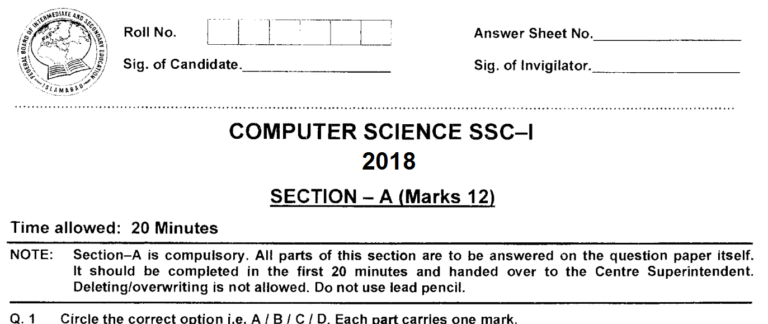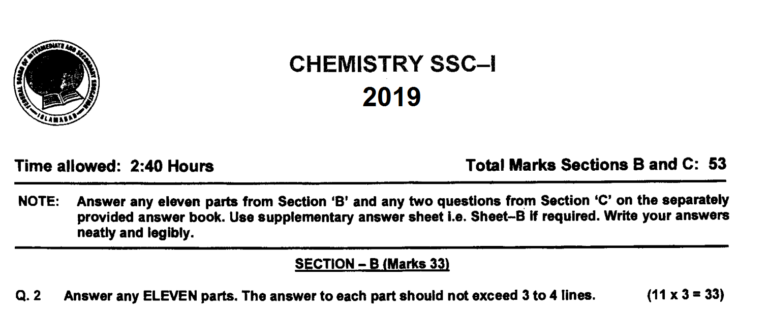Class 9 Biology Solved Paper 2019 Federal Board
Class 9 Biology Solved Paper 2019
Class 9 Biology Solved Paper 2019 Federal Board is presented to you in this post. You can see the more FBISE solved past papers of class 9 on our website.
Class 9 Biology Solved Paper 2019
Section A
Q1. MCQs
Class 9 Biology Solved Paper 2019
Section B
Q2. Attempt any ELEVEN parts. The answer to each part should not exceed 3-4 lines.
(i) Define the following branches of Biology:
a. Entomology b. Embryology c. Physiology
Ans. Entomology: It is the study of insects.
Embryology: It is the study of the development of an embryo to a new individual.
Physiology: This branch deals with the study of the functions of different parts of living organisms.
(ii) Why Ronald Ross used the female Culex mosquito instead of the female Anopheles mosquito in his experiments on malaria?
Excluded from Syllabus for Annual Exam 2021
(iii) Who proposed the 3-kingdom classification system and what objections were raised against this system?
Excluded from Syllabus for Annual Exam 2021
(iv) Name any three Endangered species of animals in Pakistan.
Ans. Three Endangered species of animals in Pakistan are the Indus dolphin, Indus dolphin, and Houbara bustard.
(v) Which group of organisms contain cell walls around their cells? Also, write the composition of the cell wall in each group.
Ans. Plants, Fungi, and many protests have cell walls. Plants have Primary and Secondary cell walls. Cellulose is the most common chemical in the Primary cell wall while the Secondary cell wall contains lignin and some other chemicals. Chitin is present in the cell wall of fungi. Prokaryotes (monera) have a cell wall composed of peptidoglycan that is a complex of amino acids and sugars.
(vi) How is the structure of mitochondria related to its functions?
Ans. the structure of mitochondria is related to its functions because the outer membrane of a mitochondrion is smooth but the inner membrane forms many infoldings, called cristae (singular crista) in the inner mitochondrial matrix. This serves to increase the surface area of the inner membrane on which membrane-bound reactions can take place.
(vii) Define the following:
a. Facilitated diffusion
b. Osmosis
c. Active transport
Ans. a. Facilitated diffusion
Excluded from Syllabus for Annual Exam 2021
b. Osmosis
Osmosis is the movement of water across a semi-permeable membrane from a solution of lesser solute concentration to a solution of higher solute concentration.
c. Active transport
Active transport is the movement of molecules from an area of lower concentration to an area of higher concentration. This movement against the concentration gradient requires energy in the form of ATP.
(viii) Apoptosis is considered as programmed cell death. Prove this by enlisting the steps of the process.
Excluded from Syllabus for Annual Exam 2021
(ix) Define crossing over. How is it significant?
Ans. Crossing Over
The non-sister chromatids of homologous chromosomes exchange their segments and the phenomenon is known as crossing over.
The exchange of segments results in the recombination of genetic information. After crossing over, each pair of homologous chromosomes remains as a bivalent.
(x) How can enzymes lower the Activation energy?
Ans. Enzymes lower the activation energy in several ways. They may alter the shape of the substrate and reduce the requirement of energy for this change. Some enzymes do so by disrupting the charge distribution on substrates. Enzymes may also lower activation energy by bringing substrates in the correct orientation to react.
(xi) How does structure of ATP reveal that it is the energy-currency of cell?
Ans. ATP: The Cell’s Energy Currency
The major energy currency of all cells is a nucleotide called adenosine triphosphate (ATP). The ability of ATP to store and release energy is due to its molecular structure. Each ATP molecule has three subunits: (a) adenine – a double-ringed nitrogenous base; (b) a ribose – a five-carbon sugar; and (c) three phosphate groups in a linear chain.
The covalent bond connecting two phosphates is indicated by the “tilde” (~) and it is a high-energy bond. The energy in this bond is released as it breaks and inorganic phosphate (Pi) gets separated from ATP. The breaking of one phosphate bond releases about 7.3 kcal (7,300 calories) per mole of ATP.
(xii) Differentiate between Alcoholic and lactic acid fermentation.
Ans. Alcoholic fermentation:
It occurs in bacteria, yeast, etc. In this type of anaerobic respiration, pyruvic acid is further broken down into alcohol (C₂H₅ OH) and CO₂.
Lactic acid fermentation:
It occurs in the skeletal muscles of humans and other animals during extreme physical activities. This also happens in the bacteria present in milk. In this type of anaerobic respiration, each pyruvic acid molecule is converted into lactic acid (C₂H₆O₃).
(xiii) What are the reasons for the creation of Transpiration Pull in plants?
Excluded from Syllabus for Annual Exam 2021
(xiv) How are erythrocytes different from leukocytes?
Ans. 1. RBCs are anucleated but WBCs are nucleated.
2. RBCs have 4 months life span and WBCs from months to years.
3. RBCs transport oxygen to all body cells and WBCs make the immune system.
(xv) Write sources, functions .and deficiency symptoms of vitamin A.
Excluded from Syllabus for Annual Exam 2021
Q3 a. What are epithelial cells? Name their different types and write about their structure, location, and functions. (1+5)
Excluded from Syllabus for Annual Exam 2021
Q3 b. Enlist the phases of the Cell Cycle with a labeled diagram. (3+1)
Ans. Cell cycle consists of two major phases i.e. interphase and mitotic phase (M phase).

Q4 a. Describe the process of aerobic respiration in detail with the help of labelled diagram. (5+2)
Ans. Aerobic respiration is a continuous process, but for convenience, we can divide it into three main stages; 1- glycolysis, 2- Krebs cycle, and 3- electron transport chain.
Glycolysis occurs in the cytoplasm and oxygen is not involved in this stage. That is why it occurs in both types of respiration i.e. aerobic and anaerobic. In glycolysis, the glucose (6C) molecule is broken into two molecules of pyruvic acid (3C).
In the Krebs cycle, the pyruvic acid molecules are completely oxidized, along with the formation of ATP, NADH, and FADH2. Before entering in Krebs cycle, pyruvic acid is changed into a 2-carbon compound called acetyl-CoA.
The electron transport chain is the final step of cellular respiration. It is the transfer of electrons on an electron transport chain. In this step, NADH and FADH2 release electrons and hydrogen ions. These electrons are taken up by a series of electron carriers. When electrons move through the series of electron carriers they lose energy, which is used to synthesize ATP. At the end of the chain, electrons and hydrogen ions combine with molecular oxygen and form water.

Q4 b. High temperature denatures the enzymes. How? (3)
Ans. An increase in temperature speeds up the rate of enzyme-catalyzed reactions, but only to a point. Every enzyme works at its maximum rate at a specific temperature called the optimum temperature for that enzyme.
When the temperature rises to a certain limit, the heat adds in the activation energy and also provides kinetic energy for the reaction. So reactions are accelerated. But when the temperature is raised well above the optimum temperature, heat energy increases the vibrations of atoms of enzyme and the globular structure of the enzyme is lost. This is known as the denaturation of enzymes. It results in a rapid decrease in the rate of enzyme action and it may be blocked completely.
Q5 a. The process of digestion completes in the small intestine. Explain various steps of this process with a labeled diagram. (4+2)
Ans. Duodenum comprises the first 10 inches (25 cm) of the small intestine and it is the part of the alimentary canal where most of the digestive process occurs. Here, food is further mixed with 3 different secretions:
1. Bile from the liver helps in the digestion of lipids through emulsification i.e. by keeping the lipid droplets separate from one another.
2. Pancreatic juice from the pancreas contains enzymes trypsin, pancreatic amylase, and lipase which digest proteins, carbohydrates, and lipids respectively.
3. Intestinal juice from intestine walls contains many enzymes for the complete digestion of all kinds of food.
Next to the duodenum is 2.4 meters long jejunum. It is concerned with the rest of the digestion of proteins, carbohydrates, and lipids of our bite.
Last 3.5 meters long part of the small intestine is the ileum. It is concerned with the absorption of digested food. There are circular folds in the inner wall of the ileum. These folds have numerous finger-like projections called villi (singular: villus). Villi increase the surface area of the inner walls and it helps a lot in the absorption of digested food.
Q5 b. Give a comparison of Pulmonary and Systemic circulation. (4)
Ans. Pulmonary Circulation
The pathway on which deoxygenated blood is carried from the heart to the lungs and in return oxygenated blood is carried from the lungs to the heart is called pulmonary circulation or circuit.
Systemic circulation
The pathway on which oxygenated blood is carried from the heart to body tissues and in return deoxygenated blood is carried from body tissues to the heart is called systemic circulation or circuit.




sir long question are not available and spelling msitake